Rafflesia verrucosa Balete, Pelser, Nickrent and Barcelona
This Rafflesia species is named for the abundant warts that cover the
perigone lobes and diaphragm.
This species was named in the following
publication:
Balete D. S., P. B. Pelser, D. L. Nickrent, and J. F. Barcelona.
2010. Rafflesia verrucosa
(Rafflesiaceae), a new species of small-flowered Rafflesia from Mindanao,
Philippines. Phytotaxa 10: 49-57. A pdf of the article can be obtained HERE.
While conducting small mammal surveys on the southeastern slopes of Mt.
Kampalili in Davao Oriental Province of Mindanao Island, Danny Balete
noticed a small-flowered Rafflesia
along one of the high elevation trails. This mammologist
(honorary botanist), whose eyes are trained to notice details at ground
level, had already discovered two other species: R. aurantia and R. baletei. The parasitic plant
community is fortunate that Danny saw this flower, for
indeed he seems preadapted to finding new Philippine species of Rafflesia!
And what a new species it is! For anyone with even cursory
experience with Philippine Rafflesia,
this one is obviously quite different from anything previously
described. The photos below will do better than words to
illustrate the assemblage of unusual and unique morphological features
presented by this species, but here are the highlights:
- Flower size. Rafflesia
verrucosa has the smallest average flower diameter of any
species in the genus (14.5-16 cm). Previously, R. baletei from the Bicol region of
Luzon held this record (9-22 cm). This is the first small-flowered Rafflesia from Mindanao, sharing
the island with two large-flowered species R. mira and R. schadenbergiana.
- Wart morphology and distribution. As shown in the photos below,
these flowers are absolutely covered with warts. In fact, some of the
warts themselves have warts! These not only cover the perigone lobe
upper surface but also extend onto the surface of the diaphragm all the
way to the rim of the aperture.
- Wart abscission from the upper perigone lobe surface. As the
flower matures, the warts darken and begin to abscise
leaving a persistent sclerenchymatous inner tissue.
- Perigone lobe lower surface. Now for possibly the strangest
character of all! The adaxial surface of the perigone lobes is
initially covered with a dark, hardened tissue layer. As the
flower matures, this layer cracks and flakes off, leaving a pitted
inner layer.
- Perigone lobe persistence. Unlike any other Rafflesia, the sclerenchymatous
perigone lobes persist through fruiting
- Disk features. The disk is borne on a very short column and is
deeply cup-shaped with a raised margin. The processes along the
top surface of the disk (unlike any seen in other Rafflesia species) form
anastomosing laminar plates. And finally, the lower portion of
the disk is ornamented with dense pubescence.
- Anther number and size. Despite having small flowers, this
species packs a large number of small anthers beneath the disk: up to
21.
- Flower sex. Up until this point, all Rafflesia except one were
documented to have unisexual flowers. Now, R. verrucosa joins R. baletei as the only species
known to have
bisexual flowers. Studies are needed to ensure that both sexual
organs are functional.
Rafflesia verrucosa is
presently known only from the type locality, a montane forest between
1350 and 1550 m elevation. This is unusually high, for most
Rafflesia species occur in
lowland or lower montane forests. This area is
undergoing disturbance from human activities such as forest clearing
for cultivation of abaca (Musa
textilis) or cutting of rattan palms for food. The area is
currently not under protection or a management plan. As stated in
Balete et al. (2010):
"We strongly support efforts by
local people (e.g. Taocanga Tribal Council Association), environmental
organizations (e.g. Philippine Eagle Foundation) and concerned
government agencies (e.g. Department of Environment and Natural
Resources and the Department of Tourism Region XI) to place certain
portions of Mt. Kampalili under protected area and ancestral domain
management."
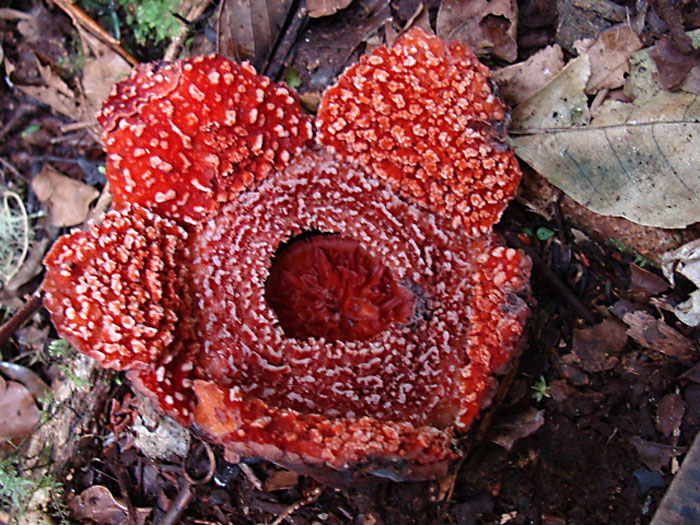
Rafflesia verrucosa flower,
top view. Note the densely packed warts all over the perigone
lobes and diaphragm.
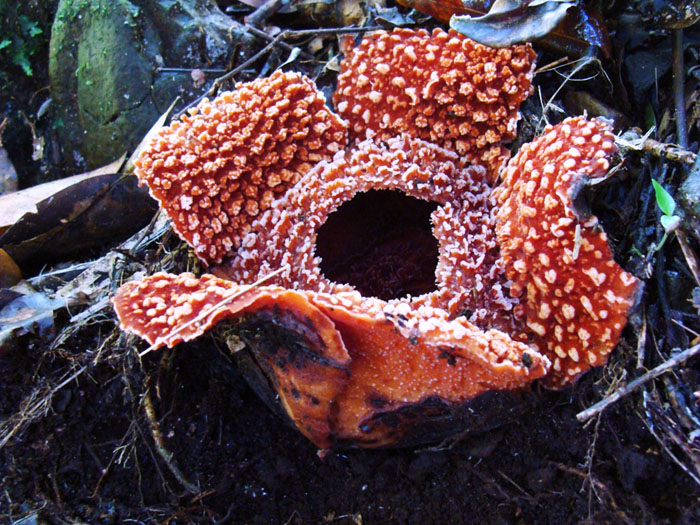
Rafflesia verrucosa flower,
showing a bit of the lower surface of the perigone lobe. Note the
dark, hardened tissue is flaking off leaving a pitted surface.

Rafflesia verrucosa flower
(fixed material). Close-up of the diaphragm showing how the warts
go all the way to the aperature opening. This photo also shows
the laminar plates that make up the processes on the top surface of the
disk.
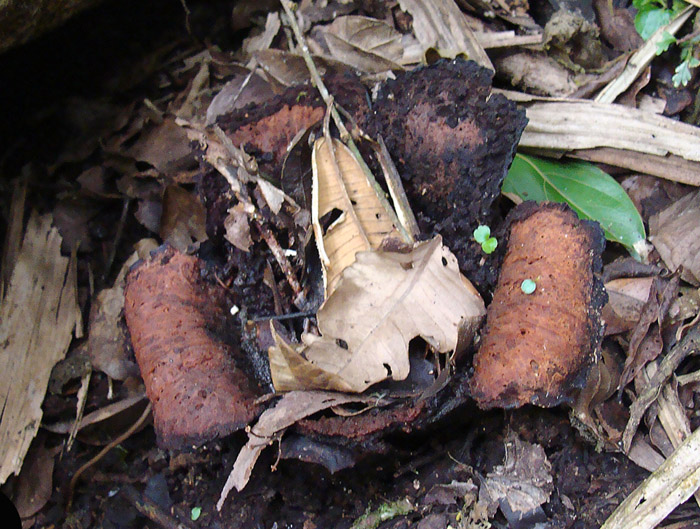
Rafflesia verrucosa flower,
beginning to senesce. The warts on the upper perigone surface
have turned black and are abscising, leaving a schlerenchymatous layer
which is persistent on the fruit.
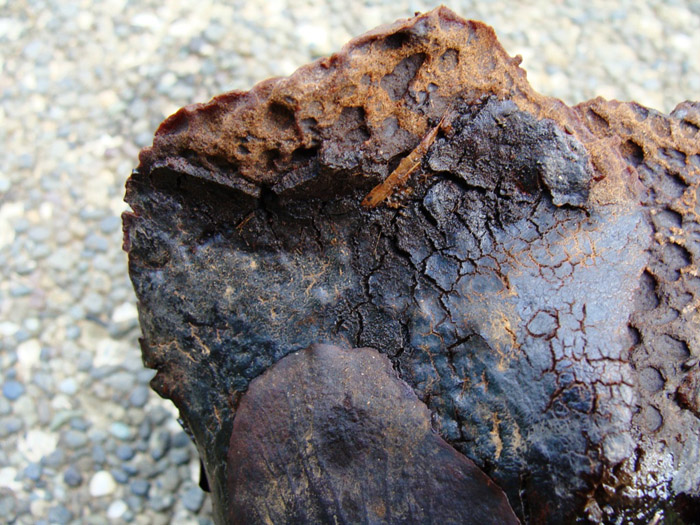
Rafflesia verrucosa (fixed
material), closer
view of the lower perigone surface as the hardened layer is beginning
to flake off.
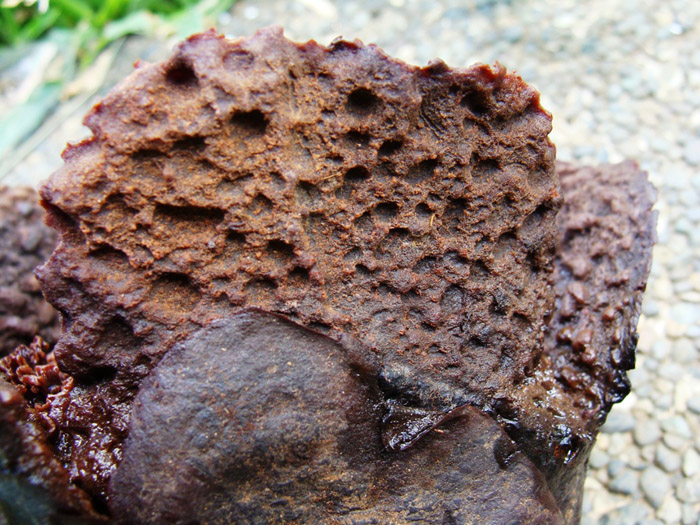
Rafflesia verrucosa (fixed
material), closer
view of the lower perigone surface, after the hardened layer has fallen
off, leaving a pitted surface on the sclerenchymatous inner layer.
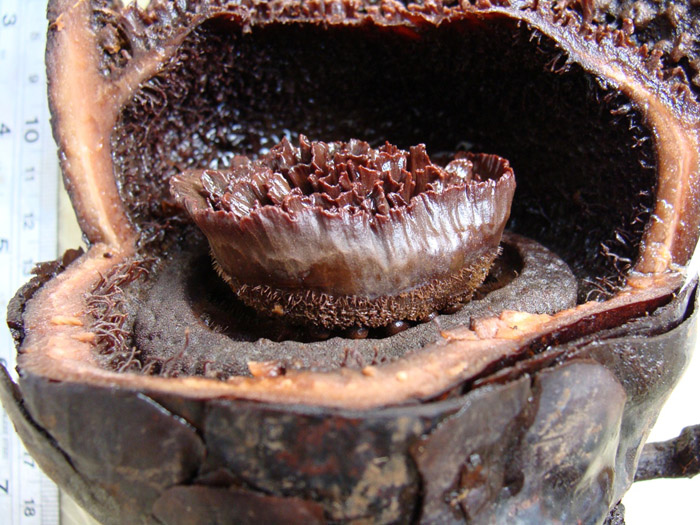
Rafflesia verrucosa flower
(fixed material) cut open showing the disk borne on a short column.
The disk has a wide, raised margin and many anastomosing laminar
plates make up the processes. The lower portion of the disk is covered
with acicular hairs. Surrounding the disk is a doughnut-shaped,
shallowly rugose annulus. Ramenta project inward toward the annulus
from the perigone tube.
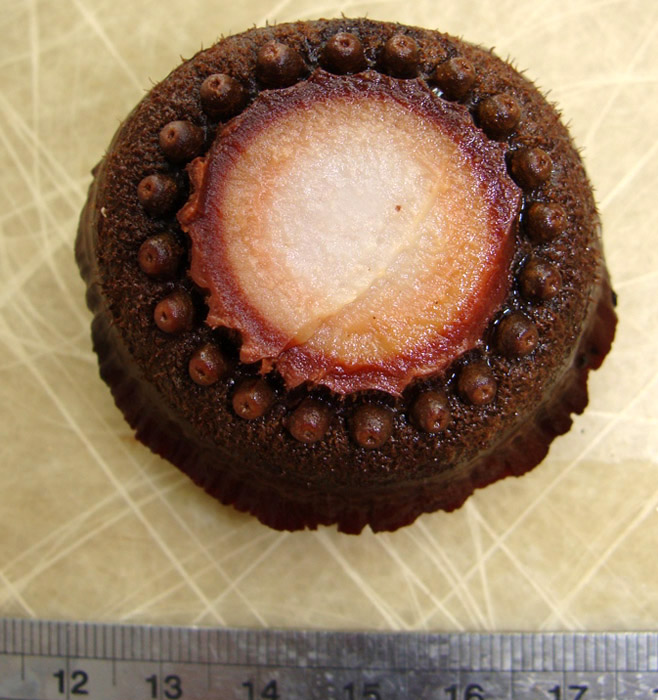
Rafflesia verrucosa (fixed
material), disk removed an turned upside down to expose the numerous
anthers on its underside.
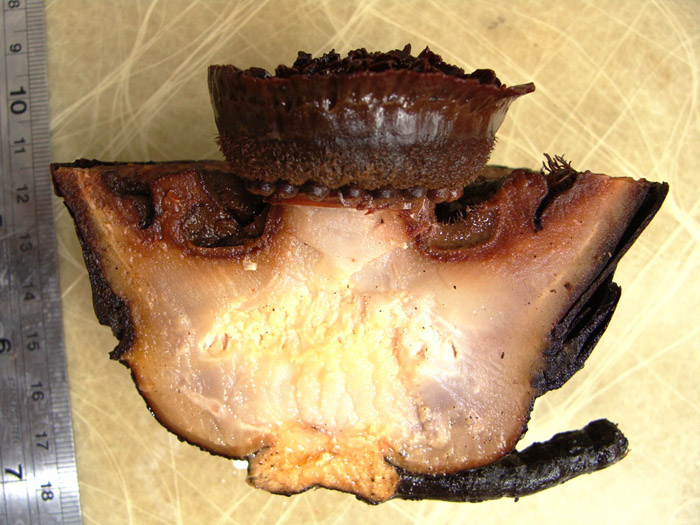
Rafflesia verrucosa flower
(fixed material) in longitudinal section showing the presence of both
anthers and ovules, thus the flower is bisexual.
Last updated: 27-July-16 / dln








